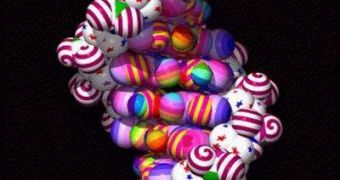The idea of linking up nanoparticles via the use of modified DNA is not a new one, and researchers have recently made some headway in that direction, when they have created pyramid-shaped structures made from the acid, with each of them housing a single nanoparticle. Now, it would seem that experts from the US Department of Energy's (DOE) Brookhaven National Laboratory have taken that idea one step further, by creating the first molecular “assembly line.” It will be used for high-precision nanoparticle construction, in a process that will be much more accurate than any other one at this time.
“When a particle is attached to a support surface, it cannot react with other molecules or particles in the same way as a free-floating particle. By controlling the number of DNA linkers and their length, we can regulate interparticle distances and a cluster's architecture. Together with the high specificity of DNA interactions, this surface-anchored technique permits precise assembly of nano-objects into more complex structures,” Center for Functional Nanomaterials research leader Oleg Gang, who is also a physicist at BNL, explains.
He goes on to say that, “When we arrange a few nanoparticles in a particular structure, new properties can emerge. Nanoparticles in this case are analogous to atoms, which, when connected in a molecule, often exhibit properties not found in the individual atoms. Our approach allows for rational and efficient assembly of nano-'molecules.' The properties of these new materials may be advantageous for many potential applications.”
The reason why the teams uses DNA is because it can maneuver the strands in such a way that they engulf nanoparticles and then only allow their “cargo” to combine with each other in very specific ways. This is achieved by making use of a basic DNA trait, which is complementarity – the four letters of the acid only combine in pairs of two.
By creating artificial strands that have certain “letters” at their ends, and loading the nanoparticles on them, the team is able to direct each of the microscopic particles and their DNA carrier into exactly the position they require in order to facilitate the construction of very complex machines inside confined spaces, such as cells in the human body.

 14 DAY TRIAL //
14 DAY TRIAL //